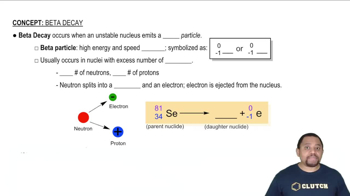An impurity in water has an extinction coefficient of 3.45⨉103 M-1 cm-1 at 280 nm, its absorption maximum (A Closer Look, p. 576). Below 50 ppb, the impurity is not a problem for human health. Given that most spectrometers cannot detect absorbances less than 0.0001 with good reliability, is measuring the absorbance of a water sample at 280 nm a good way to detect concentrations of the impurity above the 50-ppb threshold?
Ch.18 - Chemistry of the Environment
Chapter 18, Problem 83
Bioremediation is the process by which bacteria repair their environment in response, for example, to an oil spill. The efficiency of bacteria for 'eating' hydrocarbons depends on the amount of oxygen in the system, pH, temperature, and many other factors. In a certain oil spill, hydrocarbons from the oil disappeared with a first-order rate constant of 2 * 10 s. At that rate, how many days would it take for the hydrocarbons to decrease to 10% of their initial value?
 Verified step by step guidance
Verified step by step guidance1
Identify that the problem involves first-order kinetics, which can be described by the equation: \( [A] = [A]_0 e^{-kt} \), where \([A]\) is the concentration at time \(t\), \([A]_0\) is the initial concentration, \(k\) is the rate constant, and \(t\) is time.
Recognize that the problem asks for the time it takes for the concentration to decrease to 10% of its initial value, meaning \([A] = 0.1[A]_0\).
Substitute \([A] = 0.1[A]_0\) into the first-order kinetics equation: \( 0.1[A]_0 = [A]_0 e^{-kt} \).
Simplify the equation by dividing both sides by \([A]_0\), resulting in \( 0.1 = e^{-kt} \).
Take the natural logarithm of both sides to solve for \(t\): \( \ln(0.1) = -kt \). Substitute the given rate constant \(k = 2 \times 10^{-1} \text{s}^{-1}\) and solve for \(t\) in seconds, then convert \(t\) to days.
Key Concepts
Here are the essential concepts you must grasp in order to answer the question correctly.
First-Order Kinetics
First-order kinetics refers to a reaction rate that is directly proportional to the concentration of one reactant. In this context, the rate at which hydrocarbons are consumed by bacteria is dependent on their concentration. The mathematical representation involves a rate constant and can be described using the equation ln([A]0/[A]) = kt, where [A]0 is the initial concentration, [A] is the concentration at time t, k is the rate constant, and t is time.
Recommended video:
Guided course

First-Order Reactions
Half-Life
The half-life of a substance is the time required for its quantity to reduce to half its initial value. For first-order reactions, the half-life is constant and independent of the initial concentration. Understanding half-life is crucial for determining how long it will take for the hydrocarbons to decrease to a specific percentage of their initial amount, such as 10%.
Recommended video:
Guided course

Zero-Order Half-life
Exponential Decay
Exponential decay describes the process by which a quantity decreases at a rate proportional to its current value. In the context of bioremediation, as bacteria consume hydrocarbons, the concentration decreases exponentially over time. This concept is essential for calculating the time required for the hydrocarbons to reach a certain percentage of their original concentration, as it allows for the application of logarithmic functions to solve for time.
Recommended video:
Guided course

Beta Decay
Related Practice
Textbook Question
Textbook Question
The concentration of H2O in the stratosphere is about 5 ppm. It undergoes photodissociation according to: H2O(g) → H(g) + OH(g) (b) Using Table 8.3, calculate the wavelength required to cause this dissociation.
1
views
Textbook Question
The concentration of H2O in the stratosphere is about 5 ppm. It undergoes photodissociation according to: H2O(g) → H(g) + OH(g)
(c) The hydroxyl radical, OH, can react with ozone, giving the following reactions:
OH(g) + O3(g) → HO2(g) + O2(g)
HO2(g) + O(g) → OH(g) + O2(g)
What overall reaction results from these two elementary reactions? What is the catalyst in the overall reaction? Explain.
